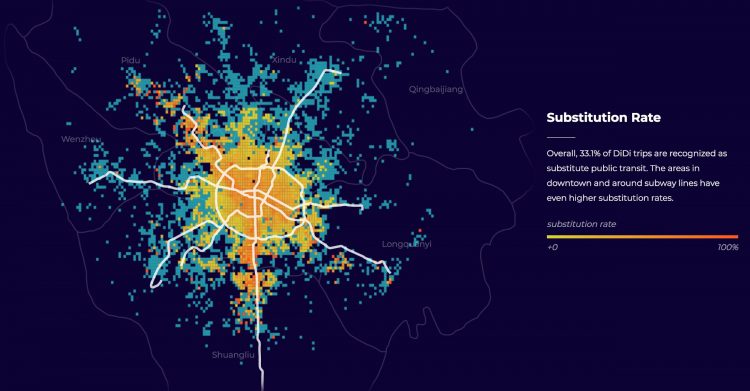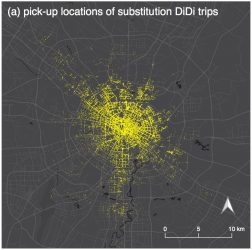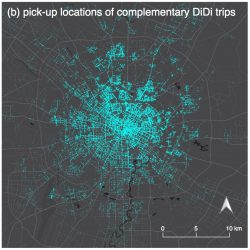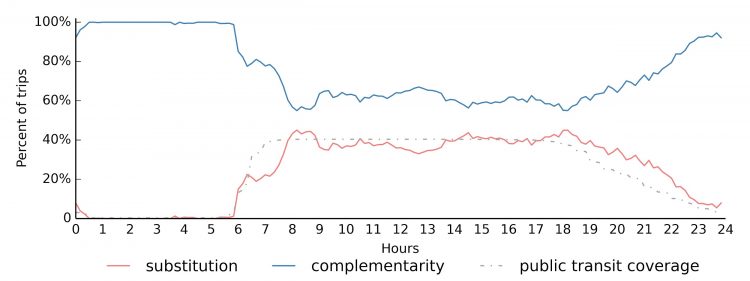How does ride-hailing substitute for public transit?
- Like
- Digg
- Del
- Tumblr
- VKontakte
- Buffer
- Love This
- Odnoklassniki
- Meneame
- Blogger
- Amazon
- Yahoo Mail
- Gmail
- AOL
- Newsvine
- HackerNews
- Evernote
- MySpace
- Mail.ru
- Viadeo
- Line
- Comments
- Yummly
- SMS
- Viber
- Telegram
- Subscribe
- Skype
- Facebook Messenger
- Kakao
- LiveJournal
- Yammer
- Edgar
- Fintel
- Mix
- Instapaper
- Copy Link
Posted: 7 August 2020 | Hui Kong, Jinhua Zhao, Xiaohu Zhang | 1 comment
Researchers from the Singapore-MIT Alliance for Research and Technology (SMART), MIT’s research enterprise in Singapore, highlight some of the key findings from their recent study into the relationship between ride-hailing and public transit.


In recent years, the explosive growth of app-based, on-demand mobility service providers, such as Uber, Lyft, Grab and DiDi Chuxing, has put ride-hailing in the spotlight. A major concern of ride-hailing, with regard to mobility and sustainability in cities, is whether it serves as a substitute for or complement to public transits.
Ideally, ride-hailing could complement transit service and help to reduce private car usage. However, as an alternative travel mode, it may also substitute for transit. While existing research suggests that ride-hailing both substitutes for and complements public transit, the extent of its effects are still unclear, as well as how these effects evolve over time and space, and what factors are impacting the effects.
The findings of this research provide significant implications for cities, agencies, and operators
To understand more about the relationship between ride-hailing and public transit, we at Singapore-MIT Alliance for Research and Technology (SMART) Future Urban Mobility Interdisciplinary Research Group and Massachusetts Institute of Technology (MIT) JTL Urban Mobility Lab recently conducted a study that measures the substitution of ride-hailing on public transit. Our findings were published in a research paper “How does Ridesourcing Substitute for Public Transit? A geospatial perspective in Chengdu, China” in the Journal of Transport Geography, and with a visualisation of the study available here. This is the first study of its kind to look into the substitution effect of each individual trip at the disaggregated level.


Figure 1. Spatial distribution of the substitution rate at the 400*400m grid
The study used DiDi data in Chengdu, China to empirically investigate the substitution effect. We proposed a three-level structure to recognise the potential substitution or complementary relationship between ride-hailing and public transit based on transit coverage, travel time difference, and service quality. A ride-hailing trip is potentially a substitute for public transit if the trip can be effectively served by public transit. Otherwise, it is considered as a complementary trip. Through the study, we found out that one-third of DiDi trips might potentially substitute for public transit.
The spatial and temporal variations of substitution were also analysed, and the substitution rate was found to be higher during the daytime (8am to 6pm) and more significant in the city centre. During the day, around 40 per cent of DiDi trips had the potential to substitute for public transit, but this substitution rate decreased in the evening as the supply of transit decreases. Also, the effect was more significant in the city centre and more developed areas covered by subway lines, while the peripheral areas were dominated by non-substitutive trips.


Figure 2. Pick-up locations of DiDi trips that substitutes and complements public transit


The findings of this research provide significant implications for cities, agencies, and operators. First, transit agencies may consider collaborating with Transportation Network Companies (TNCs) to improve the first/last mile connection. However, as ride-hailing not only complements but also substitutes for public transit, transit agencies should take precautions prior to partnering with TNCs to serve areas with poor transportation connectivity while not causing disruptive changes in public transit. It is also essential for public agencies to improve the integration of infrastructure, information, and fare, with the goal to encourage public transit and TNCs integration.
In addition, the high substitution rate in the city centre implies the necessity of ride-hailing regulations like spatial quotas or strategic pricing, and improving public transit service like shortening travel time, keeping fees affordable or crowdedness management. On the other hand, the lower substitution in suburban areas highlights instances where the current public transit service is inadequate and would help public agencies decide on the areas to implement new transit lines.
Transit agencies may consider collaborating with Transportation Network Companies (TNCs) to improve the first/last mile connection
This research shows that ridesharing has potential to substitute a big proportion of public transit, which may exacerbate the digital divide. After all, most ride-hailing services rely on smartphone apps and credit cards for payment. As a result, the unbanked population and the population that does not own a smartphone may not have access to ride-hailing services. Policymakers may have to rethink their digitalisation efforts.
The COVID-19 pandemic has caused a decrease in both ride-hailing and public transit ridership, which may alter the relationship between the two. This is an interesting research direction to explore should the data be available.


Figure 3. Temporal trend of the relationship
Biographies






Related topics
Mobility Services, Multimodality, Public Transport









Thank You for this helpful article! There are many benefits that ride-hailing can give such as it is an accessible transportation.